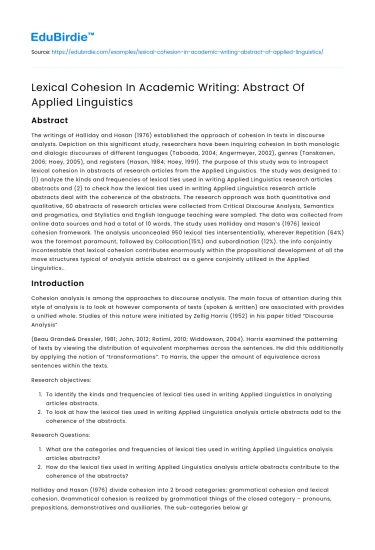Introduction
In academic writing, the ability to convey complex information clearly and cohesively is crucial. Lexical cohesion, a fundamental aspect of linguistic coherence, refers to the way in which words in a text are linked to create unity and continuity. This concept is particularly significant in applied linguistics, where the abstract serves as a concise summary of research findings and methodologies. The abstract must encapsulate the essence of the study while maintaining a coherent narrative, making lexical cohesion essential. According to Halliday and Hasan (1976), lexical cohesion is achieved through the repetition of words, synonyms, antonyms, and collocations, which collectively contribute to the overall coherence of a text. This essay explores the importance of lexical cohesion in academic writing, particularly in the context of applied linguistics abstracts, by examining its role, implementation, and challenges.
The Importance of Lexical Cohesion
Lexical cohesion plays a pivotal role in ensuring the clarity and readability of academic texts. By establishing connections between ideas, it aids in guiding the reader through the narrative, thus facilitating comprehension. In the context of applied linguistics, where abstracts often encompass a wide array of technical terms and complex ideas, lexical cohesion becomes even more critical. As Widdowson (2007) posits, "the clarity of academic discourse is largely dependent on the effective use of lexical cohesion, which helps to maintain a seamless flow of information." For example, the repetition of key terms throughout an abstract not only reinforces the main concepts but also aids in maintaining the reader's focus on the central theme. Additionally, the use of synonyms and related terms can prevent monotony while ensuring that the text remains cohesive. Without these elements, the abstract may appear disjointed, leading to misinterpretation or loss of interest from the reader. Therefore, mastering lexical cohesion is integral to producing effective academic writing.
Save your time!
We can take care of your essay
- Proper editing and formatting
- Free revision, title page, and bibliography
- Flexible prices and money-back guarantee
Transitioning from the importance of lexical cohesion, it is essential to examine the various techniques employed to achieve it. These techniques are instrumental in enhancing the overall coherence of academic texts.
Techniques for Achieving Lexical Cohesion
Several techniques are employed in academic writing to achieve lexical cohesion, each contributing to the text's overall coherence. Repetition, a fundamental technique, involves the deliberate use of the same word or phrase throughout a text to emphasize its importance. In applied linguistics abstracts, repetition can underscore key terms or concepts, ensuring that they remain at the forefront of the reader’s mind. Another technique is the use of synonyms and antonyms, which can introduce variety while maintaining a connection to the original term. This approach not only enriches the text but also enhances its readability by preventing redundancy. Furthermore, the strategic use of collocations, or the habitual juxtaposition of a particular word with another, can create a sense of familiarity and predictability, thus aiding comprehension. For instance, in a study on language acquisition, the collocation "language development" might frequently appear alongside terms like "cognitive growth" and "linguistic progress," creating a cohesive narrative thread. These techniques, when effectively employed, contribute significantly to the lexical cohesion of a text, enhancing its clarity and coherence.
While the techniques for achieving lexical cohesion are varied, it is also important to consider potential challenges and counterarguments that may arise in their application.
Challenges and Counterarguments
Despite the clear benefits of lexical cohesion, its implementation in academic writing is not without challenges. One potential drawback is the overuse of repetition, which can lead to redundancy and a lack of engagement. Critics argue that excessive reliance on repetition may detract from the text's originality and intellectual depth. However, this concern can be mitigated by balancing repetition with synonyms and related terms, thus maintaining cohesion without sacrificing variety. Another challenge is the potential for ambiguity when using synonyms and antonyms, as subtle differences in meaning may lead to misinterpretation. As Hyland (2004) notes, "the misuse of lexical cohesion techniques can result in confusion and a lack of clarity, undermining the text's overall coherence." To address this, writers must exercise precision and discernment in their choice of words, ensuring that the intended meaning is preserved. Additionally, the effective use of collocations requires a deep understanding of the subject matter and its associated terminology, which may pose a challenge for novice writers. By acknowledging these challenges and adopting a strategic approach, writers can harness the power of lexical cohesion to enhance their academic texts.
Having explored both the techniques and challenges of lexical cohesion, it is imperative to conclude with a reflection on its overall significance in academic writing.
Conclusion
In conclusion, lexical cohesion is a critical component of academic writing, particularly in the field of applied linguistics. It ensures that texts are coherent, readable, and engaging, thereby facilitating the effective communication of complex ideas. Through techniques such as repetition, synonyms, antonyms, and collocations, writers can achieve a cohesive narrative that guides the reader through their research. While challenges such as redundancy and ambiguity exist, they can be mitigated through careful word choice and strategic implementation. As academic discourse continues to evolve, the importance of lexical cohesion remains undiminished, underscoring its role in producing clear and impactful writing. By mastering the art of lexical cohesion, writers can enhance the clarity and coherence of their work, ultimately contributing to the advancement of knowledge in their respective fields.






 Stuck on your essay?
Stuck on your essay?

